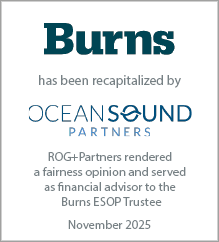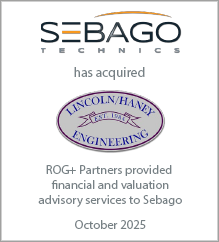Michael S. O'Brien is a principal in the Washington, DC office of Rusk O'Brien Gido + Partners. He specializes in corporate financial advisory services including business valuation, fairness and solvency opinions, mergers and acquisitions, internal ownership transition consulting, ESOPs, and strategic planning. Michael has consulted hundreds of architecture, engineering, environmental and construction companies across the U.S. and abroad.
Ownership Transition Planning:
Begin at the End
October 15, 2024
The oracle of Omaha, Warren Buffett, once said, “Someone is sitting in the shade today because someone planted a tree a long time ago.” I’m often reminded of this quote when I think about ownership planning and the critical elements of a successful transition.
It’s vital to approach ownership planning by starting with the end in mind. While ownership transition is often perceived as a straightforward matter of transferring assets and control, it actually requires a much broader spectrum of goals and strategies. Most importantly, effective ownership planning begins with a clear vision of the desired outcome.
Every decision in the planning process, no matter how seemingly insignificant, can create a ripple effect. For instance, a company that restricts ownership to a small select group may overlook the potential of young talent, causing them to view ownership as an unattainable dream. Similarly, a firm that prioritizes stock value growth without considering total return on investment could miss opportunities to foster employee investment and engagement.
Below is a step-by-step guide I find helpful when assisting firm leaders in developing a comprehensive ownership transition plan.
Steps for Effective Ownership Planning
- Assess the Current State and Future Vision:
- Where is your company today?
- What will it look like in ten years?
- What decisions must be made today to align with this vision?
- Will there be more shareholders?
- How will the concept of ownership evolve?
- How will you attract and retain the people you will need?
2. Define Clear End Goals:
- What does ownership mean for your organization?
- Who will be invited to invest?
- What does success in ownership look like?
- How many shareholders are ideal?
- How should ownership be distributed?
3.Work Backwards to Identify Steps:
- Once you have defined your goals, reverse engineer the necessary steps and ownership structures to achieve them.
- Are there too many or too few shareholders?
- What criteria will govern ownership?
- How does stock value affect your end goals? Are there barriers to value creation that could lead to unintended consequences?
- How will returns on investment be structured?
4.Establish Clear Ownership Responsibilities:
- Assign accountability for each step in the plan.
- Form special committees to oversee the evolution of the ownership plan, ensuring that responsibility is shared across generations.
5.Communicate the Vision:
- Share your end goals and ownership plan with all stakeholders to foster collaboration and commitment.
- Ensure alignment with corporate values to minimize turnover and enhance morale.
- Promote transparency to encourage employee participation in the company’s ownership.
6.Monitor and Adjust:
- Regularly review and adapt the ownership plan as needed. Flexibility allows for adjustments in response to changing circumstances while keeping the end goal in focus.
7.Engage Professionals:
- Given the complexities of ownership programs, consult with financial, tax, and legal advisors to develop a comprehensive plan.
Ownership planning that begins with the end in mind is a strategic approach that enhances clarity, accountability, and alignment within organizations. By defining desired outcomes first, businesses can create a roadmap that guides their actions and decisions, ensuring that everyone is working toward a common goal. This method not only facilitates smoother operations but also increases the likelihood of achieving long-term success. Embracing this mindset transforms ownership planning from a reactive process into a proactive strategy, setting the stage for a thriving future.
Hear Michael O’Brien present this topic at the ROG Growth and Ownership Conference in Naples, Florida, November 6 – 8.









